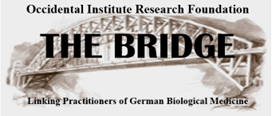The emotional components of disease can be elusive. It is much easier to focus purely on the physical aspect of the person sitting in front of you. But for many of those more difficult cases, the emotional component of the condition will decide the ultimate course of healing. I would like to focus on the symbolic aspect of how the emotional component can affect musculoskeletal cases.
The body presents a symbolism that can help us discover and address the blockages in our lives. Sometimes these symbols are universal but they can also be cultural or personal. They can be obvious or they can be subtle and require ongoing examination to unfold the layers. Sometimes it is a one-time lesson and sometimes they are lifelong reminders. Body symbolism can act like a messenger and if we can interpret those messages accurately, we can help the patient enter a new dimension of health.
These ideas will not apply to every patient, and not every patient is at a point in their lives where they are willing to consider the emotional or mind/body components of their health challenges. Some practitioners will not feel comfortable crossing into the more personal areas of their patient’s lives. However, being aware of these concepts can help the practitioner manage his cases more effectively.
I use these principles in cases where I know my diagnostics have been accurate and the actual treatment process has been good, but the results are either nonexistent or slow, or seem to have hit a plateau for no reason. I never use this information as a club or an accusation. This is not about blaming the patient. It is about leading them into a discovery process so they can learn about themselves. I use my sense of humor to keep it light “You know – (raise my eyebrows and roll my eyes) sometimes when things are not coming along as expected, there can be some emotional factors that are interfering with the healing process.”
Patients seem to be more receptive to the concept of “emotions” as opposed to “mental”. If that sails over the patient’s head and there is no curious response, then that’s as far as I go. I will manage the case on a purely physical level and refer the patient to another type of practitioner if the progress remains impeded.
If the patient becomes interested and asks the next question (“really” – “like what?”) then I know there is some ground to work with. My next response is to throw out a basic idea and let them think about it. Sometimes they recognize it right away and sometimes they have to think about it in private, leading to ongoing little discussions. This doesn’t need to take a lot of time. It’s about asking the right questions, in an attitude of love, so the patient can make the discovery for themselves. It is of no help to them if I am the one providing all the answers.
The most change will occur when they figure it out for themselves. Sometimes on the next visit, they will share how they investigated the issue. Sometimes they don’t and I never push. Once again, this is all about the patient discovering new things, not about what I know or what I think. If it looks like the patient is in or heading towards crisis, I encourage them to seek professional counseling.
Since my primary practice is chiropractic, I will focus on the musculoskeletal system, although organic disease symbolism is very interesting.
The Basics of Musculoskeletal Symbology
- Neck Pain: Issues of “flexibility of thought” and the willingness to look at things from various perspectives.
- Thoracic Pain: Issues of “protecting the heart”, deep hurt perhaps coupled with rejection of love they have offered.
- Lower back pain: “Support” issues which usually involve others but can be about money. The perfectionist who sometimes needs to learn to nurture themselves and be more realistic with their expectations of others.
- Shoulder pain or frozen shoulder: “Carrying” issues sometimes coupled with resentment or anger about carrying other’s responsibility.
- Wrist: “Creative flexibility” issues sometimes coupled with fear of change or potential of failure.
- Hip: “Stability of movement” issues that sometimes carry insecurity, fear of change or needing to control one’s environment.
- Knee: “Pride and humility” issues sometimes indicating a need to develop a healthier self-esteem.
Case Histories
- Neck pain: A 30-year-old male presenting with chronic neck and upper thoracic pain with a history of multiple contact sports injuries. Initial spinal treatments successfully reduced pain levels by approximately 70% and then progress plateaued. Various types of soft tissue therapies were added with little substantial improvement.Mostly out of frustration I said, “You know – sometimes neck stiffness and pain can be symbolic of flexibility of thought and rigidity to change. Is there anything like that going on in your life?” This was promptly followed by a groan and rolling his eyes. “My wife says I’m the most rigid person she knows and we are making changes in the house for the baby.” (His wife was about seven months pregnant at that time.) We talked for a few more minutes and I suggested that he practice “going with the flow” and to view the neck pain and stiffness as little reminders he was being resistant to change.By the next treatment, the muscle tone was improved and the condition improved from there. He requires the occasional treatment, but has been able to successfully manage his condition by being mindful of his tendency to be rigid. (His wife is delighted with this development, by the way, and has thanked me repeatedly.)
- Neck pain: A 52-year-old female presented in acute neck pain following a work related injury. She was unable to tolerate any type of manual therapy or physical therapy and a later MRI revealed multiple disc herniations. Due to allergies to anesthesia, she was fearful of even considering surgery and wanted to try to deal with the pain. As we talked, it became apparent that she was used to being the caregiver in most of her relationships and her self-identity and self-worth was largely involved in that role. Unable to continue those duties, she was in emotional turmoil as well as physical pain.With a history of abusive relationships, she had developed a very rigid outlook on life, accepting help from no one. Fortunately, her present husband is a very loving and supportive man. One of her “lessons” in this situation has been to allow her husband to love her in her “broken” condition and to recognize that she has value beyond her ability to “do” things. This has not reduced her pain (and surgery is still looming in the future) but looking at her situation through this perspective has strengthened their relationship and has allowed her to accept help and counseling from various sources (which she would not have accepted before).
- Lower Back Pain: A 55-year-old female with an acute episode of lower back pain. Manual therapy reduced pain levels about 50% and then her condition plateaued. Having worked successfully with this patient in the past, I was surprised we had hit this wall. “You know – sometimes when a condition plateaus there is an emotional component that needs to be addressed.” The patient frowned and responded “like what?” Then I continued with “Well, the lower back symbolizes support issues, the feeling that others do not support us, which may or may not be accurate, or perhaps the need to support and nurture ourselves, recognizing that we need to be able to provide that for ourselves and not be dependent on others for those needs.” She didn’t think that applied to her but said she would continue to give it some thought.When she returned the following week, she said she still didn’t think that it applied to her. I responded with “OK – Just checking”. What was interesting about this case, was that her condition started improving again at the same time. It may be that the “willingness” to examine her life allowed the energy to flow differently and get on with the necessary healing.
- Fibromyalgia patient in an auto accident: A 40-year-old female fibromyalgia patient was involved in a two-vehicle accident resulting in cervicothoracic and lumbar sprains. Dr. Christine Page (Frontiers of Health, C.W. Daniel Co. Ltd., 2000) asserts that the typical chronic fatigue and fibromyalgia patient is one who is not “walking their own path” but is trying to please the others in their life and is often not expressing their own creativity.Any practitioner who has worked with these patients has probably noticed a distinct personality type, usually of someone who is always busy taking care of everyone else and diligently putting themselves and their personal needs at the bottom of the list (which never really gets taken care of). As Christine notes, these patients will often present saying “just give me more energy to keep doing what I am doing” and are often unwilling to change the lifestyle that got them to that point in the first place.In this particular case, the patient has been barely coping on her job due to her chronic pain, and the additional pain of the injury prevented her from doing her job duties. She was restricted from work for almost a month, during which time her company had been sold to another business and she found herself unemployed. This created considerable financial problems for her family, adding to her stress. She presented in tears one day and we discussed some of the various issues that were manifesting themselves. She had found herself literally forced into change.My questions to her were: “When you were a child, what did you want to do when you grew up? What types of things really excite you, what do you love to do? What are some ways for you to express your creativity? What investments in yourself have you put off to make ‘sacrifices’ for your family?” She took these homework assignments to heart. She started journalizing on a regular basis and sat down with her family to come up with a belt-tightening budget. When she decided to return to college to continue her education, her physical condition (both the chronic pain and the sprains) made a sudden improvement. She was so excited about her future that she actually has a bounce to her step.
While these case histories may not be the best examples of using the body’s symbolism, they all have one thing in common. As I was working through these issues with the respective patients, there were moments where the healing was taken to the next level. In each of these cases, I know that I made a lasting impact on their lives, if only because I was interested enough to ask. It is knowing that I have influenced some of my patients on this deeper level that makes wading through the current healthcare bureaucracy worthwhile. It is in these types of cases that I feel I am becoming the type of healer that I desire to be and am reminded of why I do this. And that is my wish for each of you.
 An exclusive article for Affiliates
An exclusive article for Affiliates
From THE BRIDGE Newsletter of OIRF
Published December 9, 2003
© Dr. Andrea Kary, Richland, Washington USA



